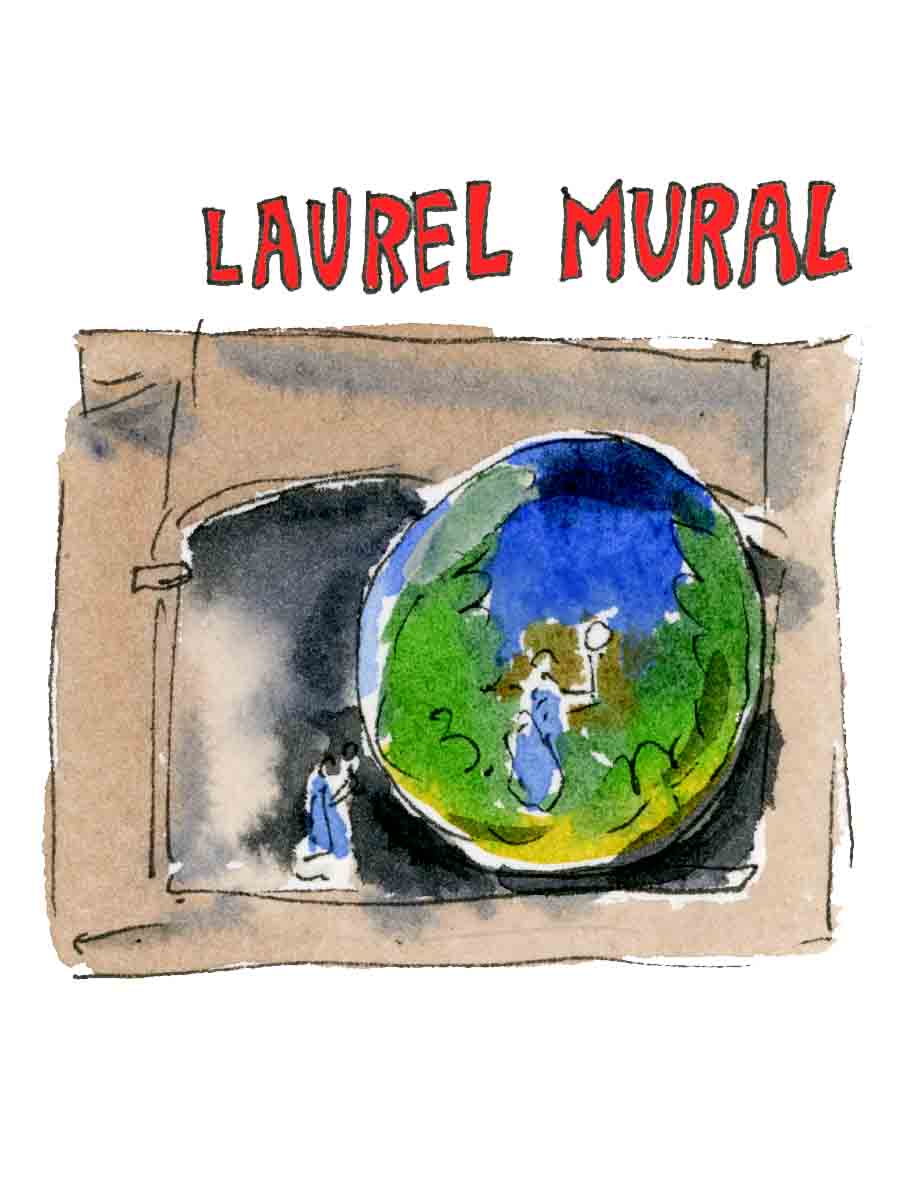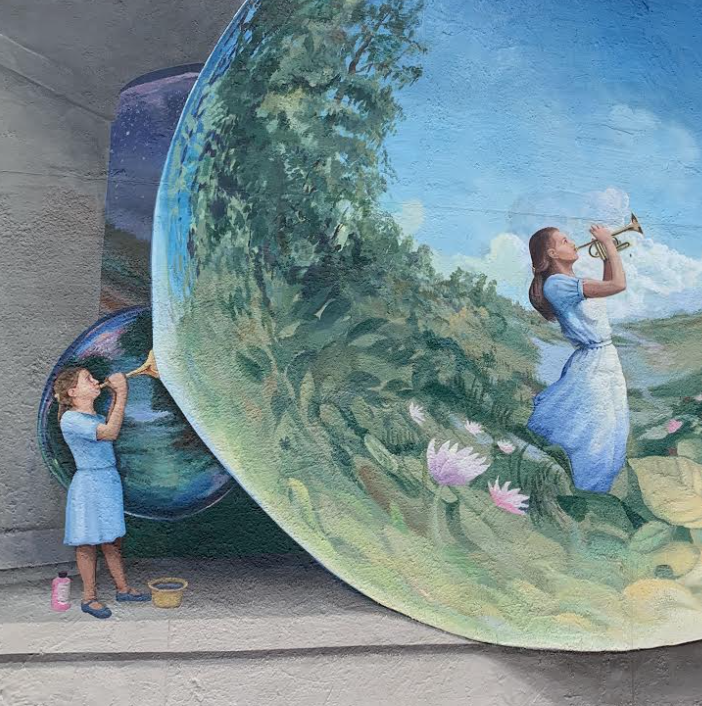The Laurel Outdoor Mural, created by artist Robert Dafford, is located at 3613 Hessmer Avenue in Metairie, Louisiana. More specifically, you will find this mural in the Metairie Business Development District, as the Jefferson Chamber Foundation and Fat City Friends commissioned this mural as part of the Fat City Mural Project funded by Council District Tourism Funds. Dafford is a current resident of Lafayette, Louisiana and has painted over 300 murals across the United States, Canada, Belgium, and England. He has been a mural artist for 35 years and directs and focuses much of his work on large, historical images of major cities and succeeds at branding his art with his unique signature, advanced perspective, and realist techniques. When considering his experience and all the work he has done throughout the course of his lifetime, Dafford must have had a distinctive outlook on the kind of message he wanted to express when creating his mural Dreams. At first glance, this mural feels a bit out of place and its significance is a little unclear; interpretations of the piece can vary from simply viewing it as an aesthetically pleasing addition in the neighborhood to deep, creative pondering on what this image is trying to say. Spending time in the hushed area, running my hand along the bumpy, rough concrete on which the image is painted with smells of freshly cut grass floating through the warm, crisp air, I felt it was a tasteful and appropriate location for the painting of Dreams.

“Dreams,” the Laurel Mural. (Illustration by: Emma Fick)
Dafford’s piece Dreams displays a young girl playing an instrument that blows out what should be sound. But instead of sound coming out the end of her instrument, there is a painted image of the young girl in the future. She is older, bigger in size, and wears a slightly different dress. Some may wonder, why is the young girl playing a future version of herself? Assuming she’s from New Orleans, she has been soaking in the music culture of her vibrant city her whole life long; she’s aware of the potential her career path holds in this passionate city, despite her upbringing in a dull portion of it. She hopes for opportunities that she knows exist, yet her life on a quiet street in Metairie puts a burden on that hope, making the mural’s placement crucial in this area as it is literally crying for help; it suggests that we can make our dreams happen, even if they don’t seem possible. The younger version of the girl stands underneath the illusion of an arch, surrounded by a painted brick wall, on a concrete ground with a bucket and bottle of paint beside her. She appears bigger than the world hidden behind half of her body. The instrument blows out a significantly larger bubble of a world where the young woman stands within it, rather than beside it. The world is bigger than her. The style choice is sort of ironic; when she’s younger, she is larger than life. When she’s older, she’s made out to be smaller and essentially less significant. As a child, she manifests her wishes and reassures herself that she can become whatever she desires to be. She has a vision of her older self and applies her own energy to blow that dream into reality. The art embodies the idea that youth is a time of unknowns, firsts, having endless experiences ahead of you; getting older is seen as shrinking, whereas youth is a time for growth. In this city more so than others, childhood and adolescence are appreciated as times of embracing your freedom and building a life with infinite opportunities to consider, whereas growing up is seen as a phase where options become gradually limited and the life clock starts ticking.

(Photo by: Chloe Shuster)
It’s not just what Dafford included in the mural that is significant; the surrounding neighborhood is sparse with only a few buildings, a few houses, and a soundless construction site which is by far the most “alive” part of the road. There was not one other person around or car cruising the street when I observed Dreams on a warm, late Sunday afternoon; I guess the timing of my visit could explain the silence in the air. This mural proposes a theme of dreaming, challenging the potential of the local neighborhood by shedding light on the idea that this place can be more full of life; it deserves to to feel more alive. Consisting of light pastel colors and a soft-edged circle embodying the image which also happens to be the first shape to catch the eye, the art’s cheerful appearance celebrates the hidden potential the local area has to come to life; it is as if a spec of hope was dropped onto a deserted street with the intention of spreading uplifting vibes and altering the dynamic of the surrounding life.
In Hilary Brown’s book, Luise Gottsched the Translator, her chapter on journalism references how classical styles of early journalism took the form of learned journals, review journals, newspapers, periodicals, calendars, and almanacs. She proceeds to point out that one of the most popular and influential types of publication during the Age of Enlightenment was the periodical essay or moral weekly. These papers concerned politics or news and even an essay that focused on a theme from everyday life designed to instruct and entertain the readers and encourage virtuous ways of living. These topics varied from morals and manners to literature, philosophy, science, and music. Considering this, I observed Dafford’s mural to be a form of modernized, alternative art in the way that it touches on themes from everyday life, such as young children looking ahead into their futures. The portrayal of only the girl’s profile, not her front side, suggests a theme of children primarily as dreamers, not knowing what path they will follow in life. We only know one side to the story when we’re young, and Dreams hides the rest of the story by capturing only one side of the girl; the rest of her story is still being written. She is manifesting another self, deeply focused on her instrument and expressing her dreams, while standing in a blissful landscape of a light blue sky and greenery.
Further, in Will Irwin’s chapter on yellow journalism in the book Highlights in the History of the American Press, he introduces the concept of yellow journalism as almost a cry for help to change up the typical, traditional journalism that was normally proposed. This change that journalists were aiming to seek eventually crept its way in by way of the business office, which actually prepared society for this new form of journalism. As a result, advertisers began to make their way into locations where you would usually never find sources of news; these places consisted of retail business stores including hardware, jewelry, and grocery stores. With sudden additions of special offerings that were designed to attract customers to the store, this sort of advertising transformed into a matter of news. Newspaper and periodical advertising started from tiny beginnings and grew into a great force of distribution. These early modifications to journalism parallel the approach to Dreams in that both the art piece and the birth of yellow journalism strived to find an alternative yet successful way to distribute news. Yellow journalism provided new locations to look for news, just as the mural Dreams does, only at the time of yellow journalism’s beginning things like art on the wall in a motionless neighborhood wouldn’t be considered a source of news the way it would today. In modern society, we now have tools like art and graffiti to express issues of all kind, not just traditional forms of journalism, and whether they be moral, religious, political, equality or any other kind of unresolved problem, art is a way of hearing what people have to say when it’s not being addressed in any other manner. Despite the dull, empty location in which Dreams is painted, Dafford must have felt that its message was worthy of sitting in such a place where this kind of meaning and significance is necessary to fill the air, to add a little umph in a silenced street, and to open the eyes of those living there and let those unheard voices be heard.
Sources:
 NOLAbeings Multimedia artist Claire Bangser created NOLAbeings as a portrait-based story project that marries...
NOLAbeings Multimedia artist Claire Bangser created NOLAbeings as a portrait-based story project that marries...  Voodoo in New Orleans: Reviving history: New Orleans fortune telling This article takes a deep dive into the history of Voodoo in New Orleans, its hybridization with Catholicism, and its present-day place in the city's culture. The author visits fortune-tellers in the French Quarter, using their guidance as a tool for introspection rather than a deterministic predictor of the future. Through her experiences in New Orleans, the author feels a mystical connection to both the past and the future.
Voodoo in New Orleans: Reviving history: New Orleans fortune telling This article takes a deep dive into the history of Voodoo in New Orleans, its hybridization with Catholicism, and its present-day place in the city's culture. The author visits fortune-tellers in the French Quarter, using their guidance as a tool for introspection rather than a deterministic predictor of the future. Through her experiences in New Orleans, the author feels a mystical connection to both the past and the future. 